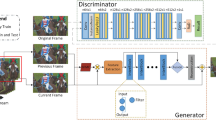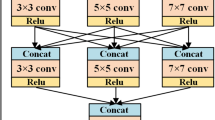Abstract
This paper considers the deep-learning-aided compressed video sensing problem. To this end, a deep generative adversarial network has been proposed to provide an approximation of the non-reference frame using its corresponding reference frame. The tests confirm the superiority of this scheme over the conventional methods used earlier. Furthermore, two scenarios have been suggested for deep compressed video sensing and recovery. In the first scenario, the difference between the non-reference frame and its approximation obtained from the pre-trained network is compressively sampled and transmitted to the receiver where the proposed residual reconstruction network is adopted to reconstruct the signal. The second scenario utilizes a pre-trained network followed by an augmented layer to approximate the non-reference frames. In the transmitter, the parameters of the augmented layer are trained for the current non-reference block. Instead of transmitting the samples of the block, the parameters of its trained augmented layer are sent to the receiver where the reconstruction is done using the same pre-trained network. The performances of the proposed scenarios demonstrate their objective and subjective superiority over the state-of-the-art algorithms in both the reconstruction quality and run time.









Similar content being viewed by others
Data Availability
The data can be available upon reasonable request.
References
A. Agrawal, R. Verschueren, S. Diamond, S. Boyd, A rewriting system for convex optimization problems. J. Control Decis. 5(1), 42–60 (2018)
M. Azghani, A. Esmaeili, K. Behdin, F. Marvasti, Missing low-rank and sparse decomposition based on smoothed nuclear norm. IEEE Trans. Circuits Syst. Video Technol. 30(6), 1550–1558 (2020). https://doi.org/10.1109/TCSVT.2019.2907467
M. Azghani, M. Karimi, F. Marvasti, Multihypothesis compressed video sensing technique. IEEE Trans. Circuits Syst. Video Technol. 26(4), 627–635 (2015)
M. Azghani, F. Marvasti, L 2-regularized iterative weighted algorithm for inverse scattering. IEEE Trans. Antennas Propag. 64(6), 2293–2300 (2016)
E.J. Candès, J. Romberg, T. Tao, Robust uncertainty principles: exact signal reconstruction from highly incomplete frequency information. IEEE Trans. Inf. Theory 52(2), 489–509 (2006)
E.J. Candes, J.K. Romberg, T. Tao, Stable signal recovery from incomplete and inaccurate measurements. Commun. Pure Appl. Math. A J. Issue Courant Inst. Math. Sci. 59(8), 1207–1223 (2006)
C. Chen, E.W. Tramel, J.E. Fowler, Compressed-sensing recovery of images and video using multihypothesis predictions. In 2011 Conference Record of the Forty Fifth Asilomar Conference on Signals, Systems and Computers (ASILOMAR), pp. 1193–1198. IEEE (2011)
K. Dabov, A. Foi, V. Katkovnik, K, Egiazarian, Color image denoising via sparse 3d collaborative filtering with grouping constraint in luminance-chrominance space. In 2007 IEEE International Conference on Image Processing, vol. 1 ( IEEE, 2007), pp. I–313
Z. Gao, Y. Guo, J. Zhang, T. Zeng, G. Yang, Hierarchical perception adversarial learning framework for compressed sensing MRI. IEEE Trans. Med. Imaging (2023)
I.J. Goodfellow, J. Pouget-Abadie, M. Mirza, B. Xu, D. Warde-Farley, S. Ozair, A. Courville, Y. Bengio, Generative adversarial networks. arXiv:1406.2661 (2014)
D.P. Kingma, J. Ba, Adam: a method for stochastic optimization. arXiv:1412.6980 (2014)
C. Li, M. Wand, Precomputed real-time texture synthesis with markovian generative adversarial networks. In European Conference on Computer Vision, (Springer, 2016), pp. 702–716
Y. Li, F. Xiao, W. Liang, L. Gui, Multiply complementary priors for image compressive sensing reconstruction in impulsive noise (ACM Transactions on Multimedia Computing, Communications and Applications, 2024)
M. Mirza, S. Osindero, Conditional generative adversarial nets. arXiv:1411.1784 (2014)
S. Mun, J.E. Fowler, Block compressed sensing of images using directional transforms. In 2009 16th IEEE International Conference on Image Processing (ICIP) (IEEE, 2009), pp. 3021–3024
V. Nair, G.E. Hinton, Rectified linear units improve restricted Boltzmann machines. In Icml (2010)
H. Rajoriya, R. Sadiwala, Deep compressive sensing and reconstruction algorithm in wireless internet of things. J. Integr. Sci. Technol. 11(2), 487 (2023)
O. Ronneberger, P. Fischer, T. Brox, U-net: convolutional networks for biomedical image segmentation. In International Conference on Medical Image Computing and Computer-assisted Intervention (Springer, 2015), pp. 234–241
N. Sadeghi, M. Azghani, Multi-user massive mimo channel estimation using joint sparsity and non-ideal feedback modeling. Digit. Signal Process. 100, 102640 (2020)
G.B. Satrya, I.N.A. Ramatryana, S.Y. Shin, Compressive sensing of medical images based on HSV color space. Sensors 23(5), 2616 (2023)
R. Sedghi, M. Azghani, Sparsity-based mimo interference suppression technique in the presence of imperfect channel state information. IET Commun. 13(19), 3201–3206 (2019)
X. Sun, C. Tian, W. Tian, Y. Zhang, Privacy-enhanced and verifiable compressed sensing reconstruction for medical image processing on the cloud. IEEE Access 10, 18134–18145 (2022)
S. Tang, C.F. Cheang, X. Yu, Y. Liang, Q. Feng, Z. Chen, Transcs-net: a hybrid transformer-based privacy-protecting network using compressed sensing for medical image segmentation. Biomed. Signal Process. Control 86, 105131 (2023)
E.W. Tramel, J.E. Fowler, Video compressed sensing with multihypothesis. In 2011 Data Compression Conference (IEEE, 2011), pp. 193–202
V. Upadhyaya, G. Sharma, T.A. Tran, M. Salim, Compressive sensing-based medical imaging techniques to detect the type of pneumonia in lungs. In: Computational Intelligence in Medical Decision Making and Diagnosis, (CRC Press, 2023), pp. 151–168
M. Wakin, J.N. Laska, M.F. Duarte, D. Baron, S. Sarvotham, D. Takhar, K.F. Kelly, R.G. Baraniuk, Compressive imaging for video representation and coding. In Picture Coding Symposium, vol 13 (2006)
Z. Wang, Z. Wang, C. Zeng, Y. Yu, X. Wan, High-quality image compressed sensing and reconstruction with multi-scale dilated convolutional neural network. Circuits Syst. Signal Process. 42(3), 1593–1616 (2023)
K. Xu, F. Ren, Csvideonet: a real-time end-to-end learning framework for high-frame-rate video compressive sensing. In: 2018 IEEE winter conference on applications of computer vision (WACV). (IEEE, 2018), pp. 1680–1688
H. Yao, F. Dai, S. Zhang, Y. Zhang, Q. Tian, C. Xu, Dr2-net: Deep residual reconstruction network for image compressive sensing. Neurocomputing 359, 483–493 (2019)
D. Ye, Z. Ni, H. Wang, J. Zhang, S. Wang, S. Kwong, Csformer: bridging convolution and transformer for compressive sensing. IEEE Trans. Image Process. (2023)
Z. Zha, B. Wen, X. Yuan, S. Ravishankar, J. Zhou, C. Zhu, Learning nonlocal sparse and low-rank models for image compressive sensing: Nonlocal sparse and low-rank modeling. IEEE Signal Process. Mag. 40(1), 32–44 (2023)
C. Zhao, S. Ma, J. Zhang, R. Xiong, W. Gao, Video compressive sensing reconstruction via reweighted residual sparsity. IEEE Trans. Circuits Syst. Video Technol. 27(6), 1182–1195 (2016)
Y. Zhao, Q. Zeng, E.Y. Lam, Adaptive compressed sensing for real-time video compression, transmission, and reconstruction. In: 2023 IEEE 10th International Conference on Data Science and Advanced Analytics (DSAA), pp. 1–10 (2023). https://doi.org/10.1109/DSAA60987.2023.10302598
C. Zhou, C. Chen, Y. Zhang, F. Ding, D. Zhang, Mh-net: A learnable multi-hypothesis network for compressed video sensing. IEEE Access 7, 166606–166613 (2019)
Funding
The authors have received no fundings for this research.
Author information
Authors and Affiliations
Corresponding author
Ethics declarations
Conflict of interest
The authors declare that they have no Conflict of interest.
Additional information
Publisher's Note
Springer Nature remains neutral with regard to jurisdictional claims in published maps and institutional affiliations.
Rights and permissions
Springer Nature or its licensor (e.g. a society or other partner) holds exclusive rights to this article under a publishing agreement with the author(s) or other rightsholder(s); author self-archiving of the accepted manuscript version of this article is solely governed by the terms of such publishing agreement and applicable law.
About this article
Cite this article
Nezhad, V.A., Azghani, M. & Marvasti, F. Compressed Video Sensing Based on Deep Generative Adversarial Network. Circuits Syst Signal Process (2024). https://doi.org/10.1007/s00034-024-02672-8
Received:
Revised:
Accepted:
Published:
DOI: https://doi.org/10.1007/s00034-024-02672-8




